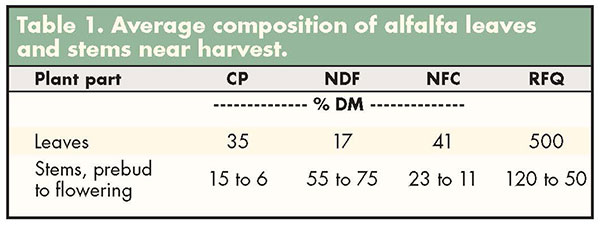The author is an extension forage agronomist with the University of Wisconsin-Madison.

The reason leaf content is so critical is that leaves have two to four times the crude protein (CP) concentration of stems, less than one-third of the fiber, and twice as much nonfiberous carbohydrate (NFC). (See Table 1.) Further, leaves don’t change much in quality as the plant matures, while stems increase in neutral detergent fiber (NDF), and decline in protein and fiber digestibility.

There is a need to focus attention on growing and harvesting alfalfa leaves. Recognize that leaves on the ground or green dust during harvest are a loss of dry matter and, more importantly, forage quality. Figure 1 shows that each 5 percent in leaf loss results in 1.2 percent less protein and 2.2 percent more NDF.
The traditional 20 percent CP and 40 percent NDF forage for dairy cattle are assuming 45 percent leaves and 55 percent stems (as indicated in Figure 1). The following practices may be helpful in keeping leaves through the harvesting process.

Timely cutting needed
Look for leaves on the ground in the standing alfalfa at mowing. If there is a significant amount, then leaf disease is likely the cause. Diseases are often prevalent in the cool, wet environments of the Midwest and Northeast. Foliar fungicides may be economical in reducing leaf drop. The problem is that fungicides must be applied before the diseases occur. So, when using fungicides, leave an untreated strip to see if a difference in leaf drop is visible.
Alfalfa is the highest quality when cut and declines in quality throughout the harvesting process. Cut when quality is sufficiently high for the animals being fed. This means harvesting alfalfa at a 28-inch height or bud stage (whichever comes first) for dairy and a 32-inch height or 10 percent flower for growing animals. Our data has shown that alfalfa NDF climbs 0.4 units per day and fiber digestibility declines 0.4 percent per day in the spring.
Spread hay in a wide swath (covering 70 to 80 percent of the cut area) to minimize NFC loss due to plant respiration. The goal is to drive-off the first 15 percent moisture as quickly as possible to slow down respiration. This will reduce overall drying time and preserve more of the starch and sugar for the animals being fed. Respiratory losses can reduce yield by 4 percent and RFQ (relative forage quality) of the forage by 20 points or more.
Machine losses mount
Move the wilting forage as little as possible between mowing and harvest. Every time forage is moved, leaves are lost. The wetter alfalfa is when moved, the lower the leaf loss. So, raking at 50 percent moisture causes less leaf loss than raking at 40 percent moisture. Every additional operation beyond the one raking or merging causes additional dry matter and forage quality loss.
Minimize leaf loss during harvest. Many have grown accustomed to a layer of green fines falling onto the ground as bales come out of the baler. This should be recognized as a loss of leaves. We are dropping the 500 RFQ forage on the ground and thereby increasing the percentage of stems (50 to 120 RFQ forage). Similarly, with a round baler, consider how many fines are falling between the belts as the bale is being made.

Losses can also be significant when harvesting for haylage with a chopper. Figure 2 is a graph of forage quality samples taken at different stages in the harvesting process by an intern in the Croplan (Winfield) internship program. The graph shows minimal forage quality loss in mowing/conditioning and merging (7 RFV total), and then a loss of 18 points RFV in the chopping process. Losses of leaves during chopping can be significant as the fine material blows out of the truck or wagon and creates a cloud of green.
Five to 10 percent or more of the forage dry matter can easily be lost during harvesting. These dry matter losses reduce yield but, more importantly, are losses of leaves that reduce the forage quality of the harvested forage. Good management is required to observe where losses are occurring and to change equipment and practices to minimize the losses.
This article appeared in the April/May 2016 issue of Hay & Forage Grower on paged 26 and 27.
Not a subscriber? Click to get the print magazine.

